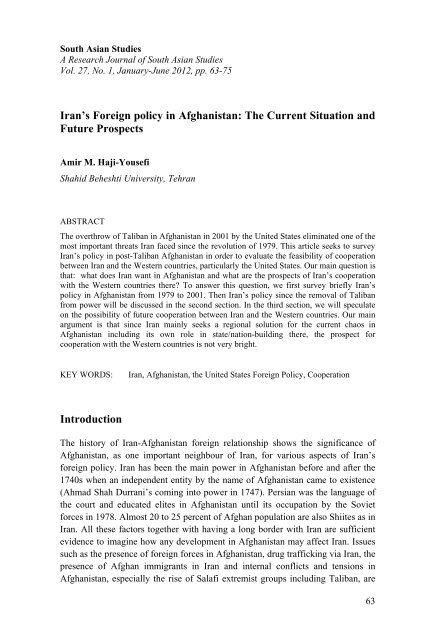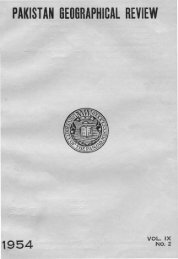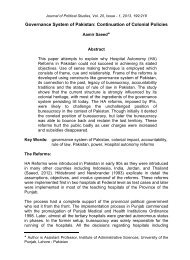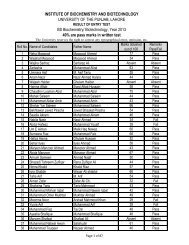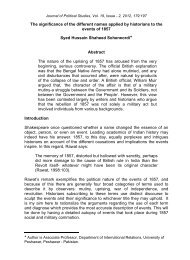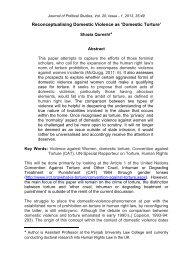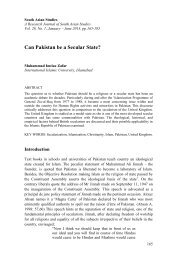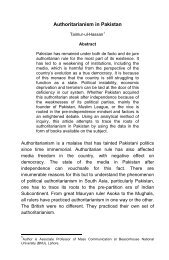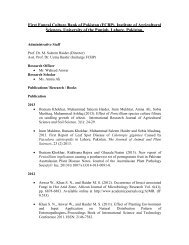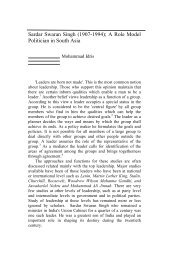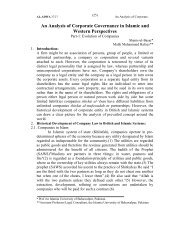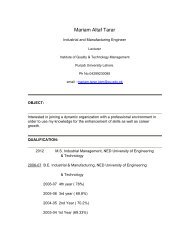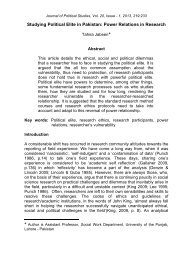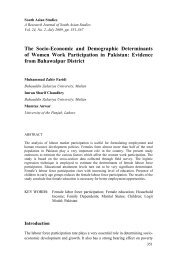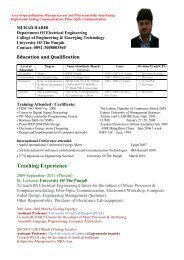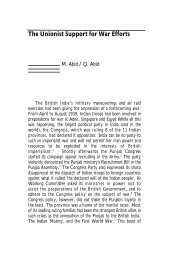4. Dr. Amir M. Haji Yousefi_January-June 2012
4. Dr. Amir M. Haji Yousefi_January-June 2012
4. Dr. Amir M. Haji Yousefi_January-June 2012
You also want an ePaper? Increase the reach of your titles
YUMPU automatically turns print PDFs into web optimized ePapers that Google loves.
South Asian Studies<br />
A Research Journal of South Asian Studies<br />
Vol. 27, No. 1, <strong>January</strong>-<strong>June</strong> <strong>2012</strong>, pp. 63-75<br />
Iran’s Foreign policy in Afghanistan: The Current Situation and<br />
Future Prospects<br />
<strong>Amir</strong> M. <strong>Haji</strong>-<strong>Yousefi</strong><br />
Shahid Beheshti University, Tehran<br />
ABSTRACT<br />
The overthrow of Taliban in Afghanistan in 2001 by the United States eliminated one of the<br />
most important threats Iran faced since the revolution of 1979. This article seeks to survey<br />
Iran’s policy in post-Taliban Afghanistan in order to evaluate the feasibility of cooperation<br />
between Iran and the Western countries, particularly the United States. Our main question is<br />
that: what does Iran want in Afghanistan and what are the prospects of Iran’s cooperation<br />
with the Western countries there? To answer this question, we first survey briefly Iran’s<br />
policy in Afghanistan from 1979 to 2001. Then Iran’s policy since the removal of Taliban<br />
from power will be discussed in the second section. In the third section, we will speculate<br />
on the possibility of future cooperation between Iran and the Western countries. Our main<br />
argument is that since Iran mainly seeks a regional solution for the current chaos in<br />
Afghanistan including its own role in state/nation-building there, the prospect for<br />
cooperation with the Western countries is not very bright.<br />
KEY WORDS: Iran, Afghanistan, the United States Foreign Policy, Cooperation<br />
Introduction<br />
The history of Iran-Afghanistan foreign relationship shows the significance of<br />
Afghanistan, as one important neighbour of Iran, for various aspects of Iran’s<br />
foreign policy. Iran has been the main power in Afghanistan before and after the<br />
1740s when an independent entity by the name of Afghanistan came to existence<br />
(Ahmad Shah Durrani’s coming into power in 1747). Persian was the language of<br />
the court and educated elites in Afghanistan until its occupation by the Soviet<br />
forces in 1978. Almost 20 to 25 percent of Afghan population are also Shiites as in<br />
Iran. All these factors together with having a long border with Iran are sufficient<br />
evidence to imagine how any development in Afghanistan may affect Iran. Issues<br />
such as the presence of foreign forces in Afghanistan, drug trafficking via Iran, the<br />
presence of Afghan immigrants in Iran and internal conflicts and tensions in<br />
Afghanistan, especially the rise of Salafi extremist groups including Taliban, are<br />
63
South Asian Studies 27 (1)<br />
among issues having great implications for Iran’s national security and the two<br />
countries bilateral relationships.<br />
Iran-Afghanistan relationship has been normal since 1919 when Iran gave<br />
formal diplomatic recognition to the government in Kabul except for three periods.<br />
The first period goes back to 1962 when there appeared some tensions on the issue<br />
of Hirmand River (Helmand in Afghan side) between the two states and continued<br />
for a number of years. The second period goes back to 1978 and the domination of<br />
communist groups in Afghanistan and subsequently the triumph of the Islamic<br />
revolution in Iran which caused a sort of serious ideological tension between the<br />
two states and the political and economic relationship of them reached practically<br />
to zero. The third period also goes back to the years of the establishment of<br />
Taliban control over Afghanistan since 1996 and the killing of Iranian diplomats<br />
in Mazari Sharif which resulted in an unprecedented crisis between the two<br />
countries. Apart from the above three periods, the two states’ relationship has<br />
usually been normal. The major point is that the presence of great powers in this<br />
country has exposed the Islamic Republic of Iran to them, the recent case of which<br />
is the presence of the U.S. and NATO forces in Afghanistan after the event of<br />
September the 11 th .<br />
This article seeks to study the prospects of the mutual relationship between<br />
Iran and the United States (plus NATO) as well as the grounds for Iranian<br />
intimacy and establishing cooperative or competitive relationship with the West in<br />
the scope of issues relevant to Afghanistan, while studying Iran-Afghanistan<br />
foreign relationship in different historical periods. The main question of this article<br />
is that: what does Iran want in Afghanistan and what are the prospects of Iran’s<br />
cooperation with the Western countries there? To answer this question, we first<br />
refer to main pillars of Iran`s foreign policy in Afghanistan. Secondly, we survey<br />
briefly Iran’s policy in Afghanistan from 1979 to 2001. Then Iran’s policy since<br />
the removal of Taliban from power will be discussed in the third section. In the<br />
final section, we will speculate on the possibility of future cooperation between<br />
Iran and the Western countries. Our main argument is that since Iran mainly seeks<br />
a regional solution for the current chaos in Afghanistan including its own role in<br />
state/nation-building there, the prospect for cooperation with the Western<br />
countries is not very bright.<br />
Principles of Iran’s Foreign Policy in Afghanistan<br />
Afghanistan has been at the core of Iranian foreign policy since the Islamic<br />
revolution in Iran. It can be stated that this country has been important for Iran for<br />
different reasons (Shafiee, 2003, Dehghani, 2009: 485-491). First, Afghanistan has<br />
a geopolitical importance for Iran meaning that Iranian foreign policy has noted its<br />
geographical and geopolitical situation. In other words, it has been and still is<br />
considered that Afghanistan is the neighbour of Iran and apart from the nature of<br />
politics and government in this country, Iran has to come to terms with the<br />
64
<strong>Amir</strong> M. <strong>Haji</strong>-<strong>Yousefi</strong> Iran’s Foreign policy<br />
governing state. It may be said that efforts made to establish a relationship with<br />
Taliban within the last two years of its ruling, can be evaluated in this framework.<br />
Afghanistan is also of great importance to Iran in terms of culture,<br />
civilization, language and ideology. Iran and Afghanistan have had historic and<br />
deep religious (Islam) and cultural (Persian language) links. Therefore, Iran has<br />
always been trying to benefit from the principal of geo-culture to advance its goals<br />
and interests in Afghanistan. So Iran has always been seeking to support and<br />
strengthen groups in Afghanistan which are culturally and religiously closer to<br />
Iran like the hazaras Shia and help them to secure their position in Afghan future<br />
politics and government. It could in turn result in more Iranian influence in<br />
Afghanistan.<br />
Afghanistan has geo-strategic significance for Iran, as well. The influence and<br />
presence of great powers in Afghanistan has brought about a serious threat for<br />
Iran’s national security. Iran has always intended to prevent the penetration and<br />
influence of great powers considered enemy in Afghanistan. Meanwhile, by<br />
developing the scope of Iranian influence in Afghanistan, the axis of a Persian<br />
civilization zone as a strategic axis would be realized.<br />
Finally, Afghanistan has a geo-economic importance for Iran. It is a<br />
considerable economic opportunity for Iran and the scope of Iranian presence and<br />
influence in Afghanistan may provide the ground achieving its economic interests<br />
there.<br />
It seems that the importance of Afghanistan for Iran in various dimensions<br />
made it difficult for Iran to decide which dimension to give priority and thus<br />
unable to make a clear decision what to do in Afghanistan. As one author argues<br />
Iran’s policy towards Afghanistan has always been affected by diversity of views<br />
inside the decision-making circles and thus has suffered from confusion and nondecision<br />
(Tajik, 2004: 150-151). Accordingly, the Iranian foreign policy towards<br />
Afghanistan has had numerous fluctuations, different periods of which will be<br />
shortly surveyed below.<br />
Iranian Foreign Policy in Afghanistan from 1979 to 2001<br />
From 1979 to the end of the Soviet Occupation<br />
The Saur Revolution or the Communist coup in 1978 in Afghanistan and the<br />
invasion of the Soviet forces to Afghan territories in the coming year, which had<br />
provoked the U.S. concern over this occupation, turned Afghanistan into the battle<br />
ground of the two superpowers (Daheshyar, 2008). Although opposing the U.S.,<br />
Iran believed that Communism is far more dangerous. Moreover, the Islamic<br />
Republic triumphed ideologically with the slogan of “No East, No West”, so it<br />
could have no tendency towards none. The official position of Iran was that the<br />
Islamic Republic of Iran is after an Islamic, independent and non-aligned<br />
65
South Asian Studies 27 (1)<br />
Afghanistan and does its best to realize the demands of Muslim Afghan people<br />
(Mojdeh, 2009). The Islamic Republic of Iran opposed the Communist coup in<br />
Kabul and this opposition was reiterated even more seriously when the Red Army<br />
occupied Afghanistan on Dec. 1979. Iran was the first state to condemn the<br />
military occupation of Afghanistan by the Soviet Union. The Communist<br />
government in Kabul also considered the victory of the Islamic revolution as a<br />
serious danger next to itself and took a negative position towards Iran. Within a<br />
short time, the two countries deported the others diplomats and many of the<br />
mutual agreements were annulled. It was then when the armed resistance of<br />
Afghan Mujahideens against the pro-Moscow communist regime was formed.<br />
Iranian foreign policy in Afghanistan during the occupation of this country by<br />
the Soviet Union was affected by some factors such as deep concern over the<br />
Soviet threat, Iran’s internal issues and problems resulted from the newly formed<br />
state of the Islamic Republic of Iran and the war with Iraq, and finally the<br />
extensive presence of opposing and rival states such as the U.S. and Saudi Arabia<br />
in Afghanistan. Therefore, Iran’s foreign policy in this period was associated with<br />
some sort of ambiguity and prudence. It may be claimed that the revolutionary<br />
Iran was acting idealistically rather than realistically in its foreign policy regarding<br />
Afghanistan during this period, aimed at preparing the ground for the Soviet<br />
withdrawal as well as securing its status and central role in the post-occupation<br />
state through supporting different Afghan groups affiliated to Tehran such as the<br />
Shiites.<br />
The Mujahideen Government and Internal Turmoil<br />
After the Soviet forces pulled out of Afghanistan on February 15 th , 1989, it took<br />
almost two and half a year for the Soviet puppet regime -Najibullah Regime- to be<br />
ousted from power. In April 1992, the Mujahideen forces seized Kabul and<br />
Sibghatullah Mojaddadi, as the first president of the interim government, came<br />
into power. After serving a two-month term, he transferred power to Burhanuddin<br />
Rabbani, based on a prior agreement reached by Mujahideen. Within the following<br />
four years from 1992 when president Najibullah`s regime was overthrown to 1996<br />
when the Taliban forces took over Kabul, attempts by Mujahideen to bring<br />
stability to Afghanistan was unrewarding. Although the Mujahideen government<br />
was in power, conflicts among numerous Afghan groups impeded the formation of<br />
a national unity government which could bring about stability and security in<br />
Afghanistan (Pahlavan, 1998). Power seeking of some warlords and their affiliated<br />
parties and groups such as Rabbani, Hekmatyar and Ahmad Shah Masoud as well<br />
as foreign meddling in Afghanistan by countries such as the United States,<br />
Pakistan, Saudi Arabia and Iran became the origin for a civil war among various<br />
Afghani groups (Marsden, 1998: 46-49). As civil war became more sophisticated,<br />
Iran’s foreign policy in Afghanistan faced a dilemma. Stressing on the Afghani<br />
people right of self-determination, Iran supported legal governments of Mojaddadi<br />
and Rabbani during the Mujahideen era. Iran was highly concerned about the<br />
internal turmoil in Afghanistan and was trying to bring about internal compromise<br />
among various Afghani groups through planning and holding several meetings and<br />
66
<strong>Amir</strong> M. <strong>Haji</strong>-<strong>Yousefi</strong> Iran’s Foreign policy<br />
conferences among them. Though the efforts continued by Iran to make a<br />
compromise among Mujahideen, however, the civil war in Afghanistan did not<br />
end.<br />
The Taliban Government<br />
Taliban entered Kabul on September 26, 1996 and the Afghan Islamic government<br />
forces withdrew to Panjshir and North of Afghanistan. A 6-person council led by<br />
Molla Mohamad Rabbani, replaced the Mujahideen government in Kabul. Russia,<br />
India, Iran and the Central Asian countries condemned Taliban actions and<br />
considered their military victory as a great risk for the peace and security in the<br />
region (Mojdeh, 2003: 20). Meanwhile the Taliban new-established government<br />
was officially recognized by three states of Pakistan, Saudi Arabia and the United<br />
Arab Emirates (Mojdeh, Ibid, 131). The emergence of Taliban and their violent<br />
views and actions led to new tension in the region, worried Iran more than<br />
anything else.<br />
The rise of Taliban in Afghanistan was considered by the Iranian government<br />
as one of the most important post-revolution threats to its national security as well<br />
as one of the major challenges to Iranian foreign policy making system. This<br />
group possessed an anti-Iran characteristic; therefore, it not only targeted the<br />
Islamic nature of the Islamic Republic of Iran, but also was a threat to its Iranian<br />
nature. Furthermore, the support Taliban received from Pakistan, Saudi Arabia<br />
and the United States, provided grounds for Iranian serious concern. The massacre<br />
of Shiites in Mazari Sharif (approximately 2000 Shiites were massacred by<br />
Taliban at the time Mazari Sharif came under their control) and the martyrdom of<br />
9 Iranians (8 diplomats and one Iranian TV correspondent) by Taliban forces<br />
moved Iran-Taliban relationship into a critical state and even led the two countries<br />
of Iran and Afghanistan to the threshold of war on Sept. 1998 (Rashid, 1998).<br />
The Iranian main foreign policy goal during the reign of Taliban was to<br />
support the anti-Taliban coalition inside Afghanistan, on one hand, and participate<br />
in regional and international meetings held for the resolution of crisis in<br />
Afghanistan, on the other. Accordingly, Iranian military aid to the anti-Taliban<br />
coalition, increased after the fall of Kabul in 1996 and once again after the fall of<br />
Mazari Sharif in 1998 (Rashid, 2002: 416). Iran in the context of the group of 6<br />
plus 2 (Iran, Turkmenistan, Uzbekistan, Tajikistan, India and Pakistan, as the six<br />
neighbouring countries together with the United States and Russia) assisted the<br />
United Nations to find solution to the crisis in Afghanistan through various<br />
meetings. Iran stressed that the Taliban control over Afghanistan is not legitimate<br />
and would put the regional peace and security at risk (Jomhoori-e Eslami, 1999).<br />
Taliban was not only a regional threat for Iran but a global threat to peace and<br />
security. The horrendous events of September 11 th , 2001 attested to the rightness<br />
of Iran’s view which ultimately caused the U.S. invasion of Afghanistan the same<br />
year.<br />
67
South Asian Studies 27 (1)<br />
Iranian Foreign Policy in Afghanistan since 2001<br />
The United States occupation of Afghanistan eliminated the main ideological<br />
threat to Iran. The Taliban government in Kabul was considered in Tehran as the<br />
most important enemy and security threat for the country, since it 1) strengthened<br />
Salafi and Wahabi Islamic extremism in Afghanistan which was against Iran Shia<br />
religion, 2) massacred thousands of Shiites in Afghanistan, 3) increased planting<br />
narcotic drugs and its trafficking through Iran, 4) caused increasing overflow of<br />
Afghan immigration to Iran, and 5) killed Iranian diplomats. As we said before,<br />
Iran and Afghanistan during Taliban came very close to a total war. Hence, the<br />
downfall of Taliban by a third power would be the most favourable alternative for<br />
Iran, even if it was a country like the United States which was counted as Iran’s<br />
bitter enemy itself.<br />
It was evident that Iran should adopt a new approach in its foreign policy<br />
towards Afghanistan and its occupation from 2001. According to the main<br />
principles of its foreign policy, Iran could not accept the occupation of<br />
Afghanistan by the U.S. and Western countries, as it had not accepted the<br />
occupation of this country by the Soviet forces. However, after the occupation of<br />
Afghanistan by the U.S. and the downfall of Taliban, there were two different<br />
views among the Iranian policy makers. As one senior advisor to the then<br />
President Mohammad Khatami acknowledges: “some considered the post-Taliban<br />
Afghanistan as an opportunity for Iran, but some other considered the military<br />
presence of the U.S. behind the eastern borders of Iran as a serious threat (Tajik,<br />
2004: 151). Iranian cooperative approach towards the U.S. since the beginning of<br />
the occupation of Afghanistan indicates the dominance of the first view. The<br />
downfall of Taliban was a new opportunity for Iran to hope that it could establish<br />
security in its eastern borders and therefore, it adopted a peaceful approach<br />
towards occupying powers hoping that securing the stability in Afghanistan<br />
through the formation of a powerful government could eliminate the origin of<br />
threats and insecurities for Iran in Afghanistan. It can be said that in addition to the<br />
Taliban salafi beliefs which was considered in Tehran as a major threat to Iran’s<br />
shia version of Islam, the huge influence Pakistan had over Taliban and the<br />
possibility of its dominant position in the future of Afghanistan, played important<br />
role in making Iran seek to eliminate Taliban (<strong>Haji</strong>-<strong>Yousefi</strong>, 2005: 214-15).<br />
At the outset of the incursion to Afghanistan, Iran demonstrated its readiness<br />
to help the United States in its move against Taliban. Iran agreed to 1) close its<br />
borders so Bin Laden and Al-Qaida people could not escape through Iranian<br />
territory, 2) return any American troop forced to land in the Iranian territory<br />
during the invasion of Afghanistan, 3) ask its allies in Afghanistan Northern<br />
Alliance to facilitate the U.S. war against Taliban, and 4) cooperate with Pakistan<br />
to form a new and widespread coalition government in Kabul. Therefore, at the<br />
beginning of the U.S. invasion to Afghanistan in 2001, Iran demonstrated a more<br />
cooperative approach towards Afghanistan under U.S. control. After the fall of<br />
Taliban, as well, Iran participated actively in the Bon Conference held on Dec.<br />
68
<strong>Amir</strong> M. <strong>Haji</strong>-<strong>Yousefi</strong> Iran’s Foreign policy<br />
2001 in order to establish a new transition government in Kabul. Iran also<br />
allocated an amount of $650 million for the reconstruction of Afghanistan in the<br />
Donor Conference held in 2002. (Zarif, 2007: 75; Milani, 2006: 246-7; Dorraj &<br />
Zangeneh, 2009: 491-2).<br />
However, the subsequent events led to the strengthening of the second<br />
approach among Iranian policy makers i.e., the view which considered the U.S.<br />
presence in Afghanistan as a main source of threat. By 2002, Iran along with Iraq<br />
and North Korea were put on the “axis of evil” list. This action led the Iranian<br />
policy makers into the conclusion that the U.S. had adopted a peaceful and<br />
cooperative approach towards Iran, due to the special situation after the events of<br />
Sept. 11 th , 2001 and the particular need to accompany Iran in battling Al-Qaida<br />
and terrorism in Afghanistan, otherwise, the U.S. is still after the policy of regime<br />
change in Iran. Therefore, Iran’s opposition to the occupation of Afghanistan was<br />
reiterated and Tehran decided once again to insist on its ad hoc view that<br />
Afghanistan does not have a military solution and supported a regional solution.<br />
As Iran’s foreign minister Manouchehr Mottaki said: Iran’s leaders felt their<br />
cooperation with the United States in Afghanistan was not properly acknowledged.<br />
Accordingly, Iran decided to limit its cooperation with Afghanistan to help<br />
reconstruct the country (Varner, 2008). Therefore, we can say that although<br />
Tehran cooperated with the U.S. in its military campaign against Taliban and its<br />
immediate aftermath, the U.S. treatment of Iran caused Iran’s reiteration of its ad<br />
hoc policy of advocating a regional solution for Afghanistan problem. As stated by<br />
an Iranian diplomat, “by emphasizing the regional solution, Iranian policy in<br />
Afghanistan aimed at helping the establishment of an independent and stable<br />
government in that country”. This could, in turn, lead to returning of Afghani<br />
refugees residing inside Iran to their homeland, reducing Afghanistan rampant<br />
drug trade, and increasing bilateral economic cooperation as well as border<br />
exchanges.<br />
That’s why the Islamic Republic of Iran has participated in almost all of the<br />
conferences held on the issue of Afghanistan, has had friendly relationship with<br />
the Karzai government, and has increased its economic relationship with<br />
Afghanistan. For example, Iranian export to Afghanistan amounts to $500 million<br />
annually, while Iran has made itself obliged to reconstruct Afghan infrastructures.<br />
Such reconstruction includes multimillion dollar plans to secure the power supply<br />
of Afghan western regions with the help of Turkmenistan, and to secure the<br />
natural gas supply of Herat (Iran`s Ministry of Foreign Affairs, 2008). However,<br />
the U.S. and the Western countries involved in Afghanistan have claimed that Iran<br />
is after instability there and has a double-sided policy towards Afghanistan, from<br />
one side of which it is an apparent supporter of stability in that country, but from<br />
the other side, it believes that the establishment of stability in this country would<br />
be considered as a U.S. success and consequently a threat for itself. Allegations<br />
that Iran is supporting anti-Karzai Mujahideen and helping arm Taliban and Al-<br />
69
South Asian Studies 27 (1)<br />
Qaida are made in this context.( Iran: Afghanistan is Barometer of U.S.<br />
Relationship, 2009).<br />
It may seem logical to say that since Iran is faced with two enemies in<br />
Afghanistan i.e., the U.S. on the one hand and the Taliban on the other, she must<br />
adopt a policy in the war between its two enemies that guarantee that neither the<br />
U.S. nor the Taliban would win the war (Dehghani, 2009: 486), however, it is<br />
almost impossible to prove with hard evidence that Iran has helped its ideological<br />
enemy. The main reason for proving such claim is that since Taliban is acting in<br />
opposition to the U.S. which may fulfill Iran’s interests and inflict damage to the<br />
American forces, Iran is helping arm the Taliban in Pakistan-Afghanistan borders.<br />
Obviously, due to Iran’s legitimate security concerns, it seems rational for her<br />
to oppose the long-term presence of the U.S. troops in Afghanistan in any form (in<br />
the present form which is the continuation of the occupation or in the form of<br />
establishing military bases). We may say that, as Holiday claims, Iran was waiting<br />
eagerly for a third party such as the U.S. to enter Afghanistan and overthrow the<br />
Taliban government (Holiday, 2001), but long-term presence of the U.S. in<br />
Afghanistan is definitely considered by Iranian authorities a serious security threat<br />
to Tehran. Therefore, it seems that for the foreseeable future Iran will insists on its<br />
belief that the occupying forces have to leave Afghanistan and that a regional<br />
solution is the most feasible one. Failure of the U.S. and the Western countries in<br />
Afghanistan to bring about security in that country after ten years of occupation<br />
supports the Iranian standpoint.<br />
Iran & the U.S. (the West) in Afghanistan: Cooperation,<br />
Confrontation, or Competition?<br />
In this section we seek to speculate about the future of Iran-U.S. relationship in<br />
Afghanistan. Our main question is what is the prospect of Iran-U.S. relation in<br />
Afghanistan? Would it be cooperative, confrontational or competitive? This article<br />
argues that because of different goals and interests of the U.S. and Iran in<br />
Afghanistan, on one hand, and their differences regarding other regional and<br />
international issues on the other, the most probable scenario would be the<br />
continuation of Iran-U.S. competition and maybe confrontation not cooperation in<br />
Afghanistan.<br />
After 10 years of the presence of American and NATO forces in Afghanistan,<br />
the security situation there has not only not improved but deteriorated. Taliban<br />
forces set up military operations against the foreign troops almost every day and<br />
have the capability to inflict severe damages on them. They use road-side bombs<br />
to set on blast foreign convoys and kill many American as well as other foreign<br />
country military forces. Recently the American and NATO authorities have<br />
realised that they have to adopt a new policy in order to confront the Taliban<br />
attacks and bring about security in Afghanistan.<br />
70
<strong>Amir</strong> M. <strong>Haji</strong>-<strong>Yousefi</strong> Iran’s Foreign policy<br />
In this new policy, apparently, Iran is considered to have a very vital role to<br />
play. Some U.S. officials such as David Petraeus, the ex-commander of American<br />
forces in Afghanistan, believe that the U.S. and Iran can cooperate to bring<br />
stability and peace to Afghanistan. The NATO member states are also seeking<br />
Iran’s cooperation in Afghanistan and seem to be ready to give Iran a more<br />
significant role in strategic decision making there. It seems that Iran is able to<br />
cooperate with the United States and the NATO, but as we have already<br />
mentioned, since it has no positive experience from its cooperation with the U.S.<br />
during the invasion to Afghanistan in order to overthrow Taliban and immediately<br />
after that, it is not very much probable that Iran would consider such offers. As<br />
Boroojerdi the ex-deputy foreign minister of Iran and current parliamentarian says:<br />
“one of the Principles in Iran’s policy to promote regional security is that<br />
Afghanistan crisis can only be solved through regional mechanisms by regional<br />
neighbouring countries. Iran has always opposed the foreign countries presence in<br />
the region and believes that such presence will neither bring about regional<br />
security nor benefit the regional states rather creates lots of insecurities.<br />
Meanwhile Iran also doesn’t recognize Taliban and will not accept negotiation<br />
with a group that is definitely a terrorist group which demonstrate an unrealistic<br />
and false image of Islam (Borojerdi, 2009).<br />
Besides chaos and instability in Afghanistan which no doubt undermine Iran’s<br />
security and national interest, the U.S. military presence in Afghanistan is<br />
considered in Tehran as an existential threat. Tehran believes that the U.S. troops<br />
will remain in Afghanistan for the foreseeable future though in different format.<br />
The U.S. officials have repeatedly mentioned that they are ready to stay as long as<br />
it is required or they have asked Afghanistan authorities for permission to set up<br />
military bases throughout the country. Bagram military base in the North of Kabul<br />
and Shindand base in the West of Afghanistan, in the province of Herat, are of the<br />
most important military bases the U.S. is concerned about in Afghanistan. There is<br />
also a probability of establishing a U.S. military base in Qandahar and Mazari<br />
Sharif (Khani, 2005: 95). Americans have recently tried hard to establish a<br />
military base in Ghurian and near the Iranian border, but have not yet gained the<br />
consent of Afghan government (Madani, 2009).<br />
Therefore, Iran wants to make sure that Afghanistan would not be a base for<br />
American operations against Iran. Of course, it seems that due to its historical<br />
experience in Afghanistan, Iran is confident that such thing would never happen.<br />
The history of Afghanistan shows that the Pashto nationalism, Afghanistan<br />
geography and its ethnic configuration, led to the defeat of the Great Britain in the<br />
19 th century. Based on this analysis, Tehran is positive that the U.S. (and the<br />
NATO) forces would not succeed in Afghanistan, since not only the three<br />
historical elements which led to the defeat of the British forces as the most<br />
powerful western country in that time, still exist in Afghanistan, but the U.S. and<br />
NATO forces are facing a fourth factor i.e., the political Islam. (Daheshyar, 2009).<br />
A decade of the Soviet occupation of Afghanistan and its defeat and withdrawal<br />
71
South Asian Studies 27 (1)<br />
proves that this historic pattern has not changed and can not be changed through<br />
military force. At the present time it seems that the U.S. is committing a strategic<br />
mistake by not only keeping its forces in Afghanistan but also increasing their<br />
number with the aim of removing Taliban and defeating global terrorism<br />
(Daheshyar, 2008). After approximately a decade of war in Afghanistan, the<br />
Taliban forces are not dismantled, rather they are making their adversary accept<br />
their role in the future of Afghanistan. Their presence in the south and south<br />
eastern Afghanistan and their incursions against the NATO forces have led the<br />
Western countries including the U.S. to think of a new strategy of dealing with<br />
Taliban (Tellis, 2009).<br />
According to Tehran, the U.S. once again is in sticky situation in Afghanistan<br />
and this is the only reason the American authorities are thinking again of<br />
contacting Iran and asking her assistance (Ghafoori, 2009). Since Iran’s previous<br />
contributions to the peace and security in Afghanistan have not been<br />
acknowledged by the U.S. and NATO, the Iranian positive reaction seems far-off.<br />
However, it may open a new ground for the Iran-U.S. contacts in Afghanistan. It is<br />
in Iran’s interest that the U.S. and NATO forces come to the realization that there<br />
is no solution to Afghanistan chaos without the active participation of the<br />
neighbouring countries. This is what Iran insists on as a regional solution to this<br />
issue. As one author close to decision-making circles in the Islamic Republic<br />
argues, Iran would not cooperate with the U.S. and NATO forces if they do not<br />
accept Iran’s policy of regional solution (Mottaghi, 2010). Iran now believes that<br />
its direct and indirect cooperation with the U.S. in Afghanistan crisis especially<br />
during the American invasion to remove Taliban and immediately after that in Bon<br />
Conference did not decrease the tension in their relationship since the U.S. was<br />
looking for a separate agenda. Accordingly the natural alliance of Iran-U.S. in<br />
Afghanistan did not alter American policy of regime change in Tehran (Dehghani,<br />
2009: 490). Thus, the future of Iran-U.S. relation in Afghanistan is at best<br />
competitive and at worst confrontational.<br />
The Islamic Republic of Iran sees the military presence of the U.S. in<br />
Afghanistan and other neighbouring countries (Iraq, the Persian Gulf and Central<br />
Asia) as its encirclement in order to contain the Islamic revolution ideals, on one<br />
hand, and change the regime in Tehran on the other. Therefore, it can be said that<br />
one of the strategic goals of the U.S. in attacking Afghanistan and continuing its<br />
occupation was to prevent Iran’s influence in Afghanistan. Another main goal<br />
might be to cut the connections of Iran and Central Asia which regarded by Iran as<br />
its zone of cultural and civilization influence. Looking at the occupation of<br />
Afghanistan from this angle, it could be imagined why Tehran is harshly opposing<br />
the American and NATO presence there. Iran’s security and interest are highly<br />
threatened. Accordingly, Tehran considers the fact that the U.S. presence in<br />
Afghanistan can be effective in the provocation and creation of insecurity in the<br />
East of Iran (Khani, 2005: 88). Further, it will facilitate the presence of countries<br />
such as Saudi Arabia, a U.S. regional ally, who according to Tehran seeks to<br />
72
<strong>Amir</strong> M. <strong>Haji</strong>-<strong>Yousefi</strong> Iran’s Foreign policy<br />
substitute the Iranian influence in Afghanistan and Mecca meeting in October<br />
2008 in which Afghan authorities were said to have negotiated with Taliban for<br />
political settlement was considered as an effort to eliminate Iran from the future<br />
equations of Afghanistan (Molazehi, 2010).<br />
As former deputy foreign minister of Iran acknowledges, “If the ‘client<br />
government’ of Afghanistan changes into an ‘independent government’, then we<br />
may observe manifestations of strategic stability. If there is stability in<br />
Afghanistan, then the role of superpowers specifically the U.S. would decrease<br />
remarkably. Hence, Iran’s geo-strategic ideals require the considerable decline in<br />
the position of superpowers in the future destiny of Afghanistan. Requirements of<br />
Iran’s foreign policy in Afghanistan are based on regional constructivism.<br />
Constructivism can be considered as a ground for maximising the regional<br />
cooperative relationship. It can be fulfilled through a cooperation-based<br />
competition. If ground is ready for cooperation in economic plans in Afghanistan,<br />
signals of improvement in conditions in an international level and an environment<br />
to impact political procedures in Afghanistan may be made. The second pattern in<br />
securing Iran’s interests in Afghanistan may be recognized as the opposition with<br />
the influence of the foreign countries in this region. Iran’s strategic planning must<br />
be organized in opposing and confronting the behavioural pattern of the U.S. The<br />
less desirable is Afghanistan for the U.S., the better the situation for Iran”<br />
(Mohammadi, 2007: 227).<br />
According to Iran the settlement of crisis in Afghanistan through regional<br />
means may lead to the U.S. and Western countries` decreasing influence as well as<br />
their pull out from there. In Iranian policy making circles, it is believed that the<br />
U.S. is attempting to enlarge the gap between Iran and Afghanistan and even<br />
promote conflicts between them while regional peace and security requires that<br />
these bilateral differences to be minimized and Tehran becomes able to have very<br />
cordial and constructive relation with Kabul especially through increasing<br />
economic and trade relations. As Mohammadi says, “the cultural similarities of<br />
Iran and Afghanistan as well as Iran’s economic capabilities which can be used to<br />
support Afghan future reconstruction plans, creates a more appropriate<br />
environment for the interaction in mutual relationships (Mohammadi, 2007: 228).<br />
Accordingly, Iran’s security and national interest can be guaranteed through a<br />
friendly, stable, secure, neutral, non-aligned and moderate Afghanistan. As one<br />
Iranian career diplomat acknowledges, the Iranian policy makers` main perception<br />
is that such an Afghanistan can be achieved only through a government in Kabul<br />
which looks for a regional framework rather than extra-regional strategic<br />
cooperation with great powers to solve its problems (Mousavi, 2009). Many<br />
Afghan people, particularly those residing in the North or East of this country,<br />
seems to have also reached to the same conclusion that the presence of foreign<br />
forces has brought neither security nor welfare and happiness to them.<br />
Accordingly, the best way to establish durable stability and security in<br />
73
South Asian Studies 27 (1)<br />
Afghanistan is to develop the economic reconstruction in which the neighbouring<br />
countries, especially Iran, play an important role.<br />
Conclusion<br />
Despite of the common interests of the U.S. and Iran in overthrowing Taliban in<br />
2001, they are in loggerhead again there. The U.S. lack of acknowledging Iran’s<br />
cooperative role in Afghanistan made Tehran to choose a “no winner policy”<br />
whose aim is that neither the U.S. and NATO nor the Taliban forces win the battle<br />
in Afghanistan. Iran’s declared policy in Afghanistan is based on the regional<br />
solution for the Afghan chaos and non-tolerance of great powers` presence there.<br />
Therefore, this article concludes that Afghanistan can not be used as a bridge to<br />
establish a cooperative relationship between Iran and the U.S. The presence of the<br />
U.S. in Afghanistan is considered a major threat for Iran and thus the U.S. exit<br />
from Afghanistan not only eliminate this threat but also bring about a sort of<br />
freeing Iran’s capacities to run through its eastern borders (Tahaei, 2010).<br />
References<br />
Boroojerdi, A. (2009), “Manafe-e Moshtaraki ba Amrica dar Afghanistan Nadarim” (in<br />
Persian) (We have no Common Interest with the U.S. in Afghanistan), Vatan-e<br />
Emrooz, April 28.<br />
Daheshyar, H. (2009), “Amrica, Afghanestan va Pakestan: Se Zele naahamkhan-e yek<br />
Bohran” (in Persian) (The United States, Afghanistan, and Pakistan: Three<br />
nonadjustable sides of a Crisis), Ettelaat-e Siyasi va Eqtesaadi, Nos. 162-63<br />
Daheshyar, H. (2008), “Amrica va Paradigme Qoumi dar Afghanestan” (in Persian) (The<br />
United States and Ethnic Paradigm in Afghanistan), Ettelaat-e Siyasi va Eqtesadi, Nos.<br />
257-8<br />
Dehghani, J. (2009), The Foreign Policy of the Islamic Republic of Iran (Tehran: Samt)<br />
Dorraj, M and H. Zangeneh (2009), “Missed Opportunities and Political Blunders: The Tale<br />
of US-Iran Relations”, in Robert Looney (ed.), Handbook of US-Middle East Relations<br />
(London: Routledge)<br />
Ghafoori, Q. (2009), “Aakharin Senarioye Amrica dar Afghanestan” (in Persian) (The Last<br />
American Scenario in Afghanistan), Siyasat-e Rooz Newspaper, April 22.<br />
<strong>Haji</strong>-<strong>Yousefi</strong>, A. (2005), Siyasate Khareji-e Iran dar Partove Tahavvolat-e Mantaqaee (in<br />
Persian) (The Foreign Policy of the Islamic Republic of Iran in the Regional Context)<br />
(Tehran: IPIS)<br />
Halliday, F. (2001), “Tehran Mitavanad Naqshe Bishtar Ifa Konad” (translated to Persian)<br />
(Tehran can play more Role), Iran Newspaper, November 9.<br />
Jomhoori-e Eslami (1999), “6+2: Harekat dar Bonbast” (in Persian) (6+2: A Move in Deadend),<br />
July 19.<br />
Iran`s Ministry of Foreign Affairs (2008), Iran and Reconstruction of Afghanistan: 2001-<br />
2008.<br />
Iran: Afghanistan is Barometer of U.S. Relationship (2009), Oxford Analytical Daily Briefs<br />
Service, May 5.<br />
Khani, Ali A. (2005), Forsatha, Tahdidat va Chaleshhay-e fararooy-e amniyat-e melli-e Iran<br />
(in Persian) (Opportunities, Threats and Challenges Facing Iran`s National Security)<br />
(Tehran: Abrar Moaser)<br />
74
<strong>Amir</strong> M. <strong>Haji</strong>-<strong>Yousefi</strong> Iran’s Foreign policy<br />
Madani, H. (2009), “Abzaarha va Mohrahaye Amricayee zed-e Iran” (in Persian)<br />
(American Tools and Puppets against Iran), Payam-e Mojahed<br />
Marsden, P. (1998), Taleban: Jang, Mazhab va nazme jaded dar Afghanestan (translated to<br />
Persian by N. Khandaq) (The Taliban: War, Religion and the New Order in<br />
Afghanistan) (Tehran: IPIS)<br />
Milani, M. (2006), “Iran`s Policy Towards Afghanistan”, Middle East Journal, Spring, Vol.<br />
60, No. 2.<br />
Mohammadi, M. (2007), Aayandaye Nezam-e Neynalmelal va Siyasate Kharesi-e Iran (in<br />
Persian) (The Future of the International System and the Foreign Policy of the Islamic<br />
Republic of Iran) (Tehran: Faculty of International Relations)<br />
Mojdeh, V. (2003), Afghanestan va Panj Saal Sltaye Taleban (in Persian) (Afghanistan and<br />
Five Year of Taliban Domination) (Tehran: Ney)<br />
Mojdeh, V. (2009), “Ravabet-e Siyasiye Iran va Afghanistan az Kudataye Saur ta Payan-e<br />
Qarn-e Bistom” (in Persian) (Iran-Afghanistan Political Relations from the Saur Coup<br />
to the End of the 20 th Century), Payam-e Mojahed.<br />
Mollazehi, P. (2010), “Afghanestan: Taqabol-e Estratejiha” (in Persian) (Afghanistan: The<br />
Confrontations of Various Strategies) in M. Vaezi, ed. Kanoonhaye Bohran Dar Asia<br />
(The Crisis Centers in Asia) (Tehran: CSR)<br />
Mottaghi, E. (2010), “Arzyabi-e Moqayesaie-e Tahdidhay-e Amrica dar Barkhord ba Iran;<br />
2001-2010” (in Persian) (Comparative Evaluation of America`s Threats in Dealing<br />
with Iran), Afaaq-e Amniyat, Spring.<br />
Mousavi, R. (2009), “Risheyabi-e Bohran dar Afghanestan” (in Persian) (Searching for<br />
Root Causes of Crisis in Afghanistan), Ravabete Khareji, No. <strong>4.</strong><br />
Pahlavan, C. (1998), Afghanestan-e Asr-e Mujahedin va Baramadane Taleban (in Persian)<br />
(Mujadiheen-era Afghanistan and Rise of Taliban) (Tehran: Ghatareh Publication).<br />
Pahlavan, C. (1987), “Dolat-e Mazar: Goftari Piramoon-e Tadavome Bohran-e Mashrooyiat<br />
dar Afghanestan” (in Persian) (Mazari Government: An article on the Continuation of<br />
Legitimacy Crisis in Afghanistan), Ettelaat-e Siyasi va Eqtesadi, Nos. 123-12<strong>4.</strong><br />
Rashid, A. (2002), Taleban, Zanan, Tejarat, Mafia va Perojaye Azime Naft dar Asiyaye<br />
Markazi (translated to Persian by N. Khandaq) (Taliban, Women, Trade, Mafia and the<br />
Big Oil Project in Central Asia) (Tehran: Boqaa)<br />
Rashid, A. (1998), “Islamic Face-off”, Far Eastern Economic Review, September 17.<br />
Shafiee, Nozar (2003), “Bazi-e Qodrat dar Afghanistan: Ahdaaf va Olgooy-e Raftari” (The<br />
Power Game in Afghanistan: Goals and Behavioral Pattern), Ettelaat Newspaper, 16<br />
July.<br />
Tahaee, J. (2010), Khorooj-e Qodratmandanaye Sarie: Negahi be Vaziat-e Konooni-e<br />
Amrica dar Afghanestan (in Persian) (The Powerful and Fast Exit: A Look at the<br />
Current U.S. Situation in Afganistan) (Tehran: CSR)<br />
Tajik, M. (2004), Siyasat-e Khareji: Arsaye Foqdan-e Tasmim va Tadbir (in Persian)<br />
(Foreign Policy: Area of Non-Decision and No-Think) (Tehran: The Center of<br />
Strategic Studies)<br />
Tellis, Ashley, (2009) Reconciling with the Taliban? (Washington, D.C.: Carnegie<br />
Endowment)<br />
Varner, Bill (2008), “Iran Pours Cash Into Afghanistan, Seeking Leverage Against U.S.”,<br />
Bloomberg, July 16.<br />
Zarif, M.J. (2007), “Tackling the Iran-U.S. Crisis: The Need for a Paradigm Shift”, Journal<br />
of International Affairs, Spring-Summer, Vol. 60, No.2.<br />
Biographical Note<br />
<strong>Dr</strong>. <strong>Amir</strong> M. <strong>Haji</strong>-<strong>Yousefi</strong> is Associate Professor at Department of Political<br />
Science and International Relations. Shahid Beheshti University. Tehran-Iran.<br />
_______________________________________<br />
75


